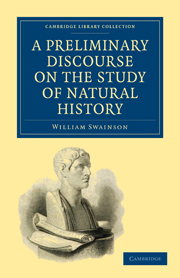Book contents
- Frontmatter
- Contents
- PART I RISE AND PROGRESS OF ZOOLOGY
- PART II ON THE GENERAL NATURE AND ADVANTAGES OF THE STUDY OF NATURAL HISTORY
- PART III OF THE PRINCIPLES ON WHICH NATURAL HISTORY RELIES FOR ITS SUCCESSFUL PROSECUTION, AND THE CONSIDERATIONS BY WHICH THE NATURAL SYSTEM MAY DE DEVELOPED
- CHAP. I
- CHAP. II
- CHAP. III
- CHAP. IV
- CHAP. V
- CHAP. VI
- PART IV ON THE PRESENT STATE OF ZOOLOGICAL SCIENCE IN BRITAIN, AND ON THE MEANS BEST CALCULATED FOR ITS ENCOURAGEMENT AND EXTENSION
- APPENDIX
- INDEX
- Frontmatter
- Contents
- PART I RISE AND PROGRESS OF ZOOLOGY
- PART II ON THE GENERAL NATURE AND ADVANTAGES OF THE STUDY OF NATURAL HISTORY
- PART III OF THE PRINCIPLES ON WHICH NATURAL HISTORY RELIES FOR ITS SUCCESSFUL PROSECUTION, AND THE CONSIDERATIONS BY WHICH THE NATURAL SYSTEM MAY DE DEVELOPED
- CHAP. I
- CHAP. II
- CHAP. III
- CHAP. IV
- CHAP. V
- CHAP. VI
- PART IV ON THE PRESENT STATE OF ZOOLOGICAL SCIENCE IN BRITAIN, AND ON THE MEANS BEST CALCULATED FOR ITS ENCOURAGEMENT AND EXTENSION
- APPENDIX
- INDEX
Summary
(129.) The innumerable objects composing the animal world, may be compared to the isolated facts of all physical sciences. For unless they are arranged and digested under proper heads, no general conclusions from them can be drawn. No sooner, therefore, has the naturalist become acquainted with the forms of the objects he studies, than he proceeds to arrange them according to their agreements and disagreements. He first places them in primary groups, as an entomologist would separate the beetles from the butterflies; and these, from the bees and the flies: from each of these, again, he proceeds to make other divisions; separating the butterflies which fly by day, from those which are nocturnal, and so on. This is arrangement or classification; from which all systems or methods originate. Now, it is obvious, that if we are not guided in this proceeding by some general rules known to be universally applicable, every one may consider himself qualified to follow his own impressions, and to make that arrangement which he thinks best. Hence have originated the innumerable systems and methods which have been, and are still, in use. One writer attaches a primary importance to particular characters, which another undervalues; a third rejects both these, and founds his system upon certain points of structure on which his predecessors have placed no value; a fourth, disregarding all outward organisation, builds his method upon internal anatomy.
- Type
- Chapter
- Information
- A Preliminary Discourse on the Study of Natural History , pp. 188 - 200Publisher: Cambridge University PressPrint publication year: 2009First published in: 1834



